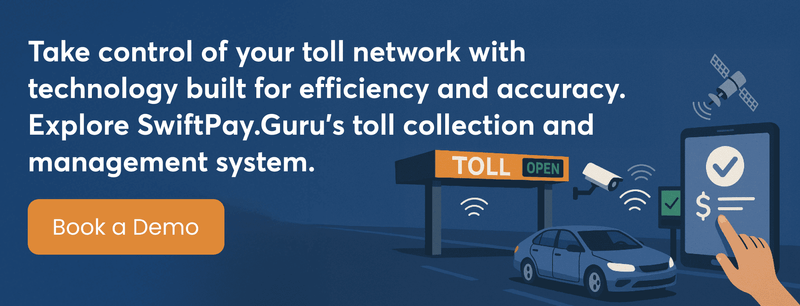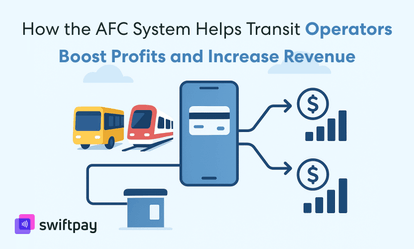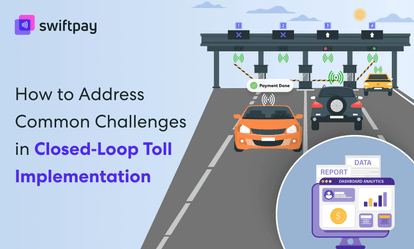Toll collection was meant to get easier with tech, right? But for many operators, it’s only become more frustrating.
As a toll Operator, you’re stuck with long queues, rising operational costs, and disconnected systems that don’t work together. Because, managing different vendors, tools, and updates takes more time than it should. Even then, you still deal with delays, data gaps, and revenue leakages.
If that feels familiar, you’re not alone.
Fortunately, the good news is that tolling is shifting toward a model that gives you more control and fewer complexities.
It’s called a closed loop toll management system.
Instead of depending on outside processors or complex integrations, a closed loop toll payment system keeps everything in your hands. You manage the payments, the user data, and the system flow all in one place.
This post walks you through the future of toll management, the tech that’s transforming it, and how you can take control.
To understand the shift, first look at why traditional toll payment systems no longer meet today’s needs.
Why the Old Payment Model Isn’t Working Anymore
If you're still running toll collection on the old payment model, you're already dealing with avoidable or unavoidable challenges.
Every transaction flows through third-party banks or external processors. On the surface, it looks like things are working. But dig a little deeper, and you'll see what's really happening: your revenue is being reduced by high transaction fees. These costs aren’t small, and over time, they eat into your margins, especially when traffic volumes rise.
The money you collect isn’t available right away, making it harder to manage your cash flow. Settlements are delayed. Settlements are delayed, and reconciliation turns into a routine headache for your team. Instead of focusing on better operations, your team ends up chasing numbers and reports across disconnected systems.
It gets worse when your payment data isn’t fully under your control. When your payment system operates separately, it limits visibility and prevents you from acting on insights in real time.
And while all this happens in the backend, drivers feel the impact at the front. The tolling process takes longer, feels clunky, and leaves people frustrated. When your toll management system adds friction instead of removing it, it’s clear the old model isn’t keeping up anymore.
What Is a Closed-Loop Toll Payment System
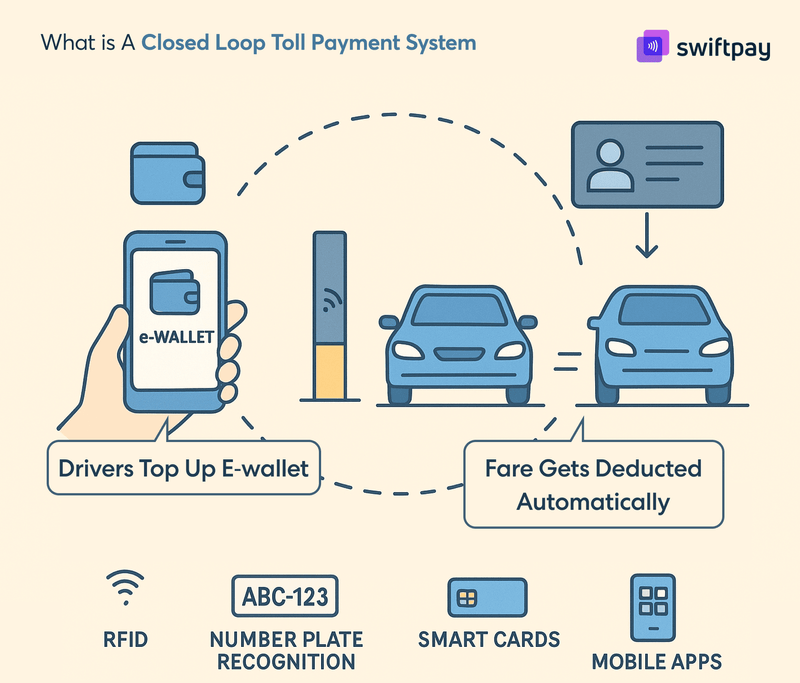
A closed-loop toll payment system is a payment model where you manage the entire toll payment process within your ecosystem. It can be achieved without relying on external banks, third-party processors, or outside payment networks. Also, it gives you full ownership of how payments are collected, processed, and settled across your toll operations.
In this closed-loop toll payment system, this is how it works:
- Drivers top up a closed loop e-wallet that’s directly linked to your toll system.
- When they reach the toll gate, the fare comes off automatically in real time.
- There is no need for cash, card taps, or third-party gateways.
- The wallet works with RFID tags, number plate recognition, smart cards, or mobile apps.
- You can set it up to match whatever your current system already supports.
Because everything stays inside your system, you avoid unnecessary transaction charges, eliminate settlement delays, and gain full visibility over every transaction. Plus, you’re not depending on outside players for something as critical as toll revenue. Instead, you control the flow from start to finish.
This approach also simplifies the driver experience. The top-up process is easy, the deductions are fast, and there's no confusion around receipts or pending payments.
This software makes toll payments simple and stress-free for your drivers. From topping up to passing through the gate, every step is designed to save time and avoid confusion:
- Easy top-up: Drivers add funds to their e-wallet quickly and effortlessly.
- Instant deductions: Payments are automatically taken at the toll gate in real time.
- Clear records: Receipts and pending payments are easy to track, which leaves no room for mistakes.
Everything works in a self-contained way, which gives you a cost-efficient, transparent, and reliable toll management system that scales with your operations.
How a Closed-Loop System Solves the Problems of the Old Toll Payment System
A closed-loop system fixes the common problems you face with old toll payment systems.
With a closed loop system, you are not just collecting tolls; rather, you are running the entire payment environment. That means:
- Reduced transaction costs: You remove middlemen like banks and card processors. This limits per-transaction charges and protects your profit margins.
- Faster settlements: Payments are processed instantly within your system. There’s no waiting period before the revenue hits your books.
- Complete control and visibility: You can see all transactions, all the accounts, all the wallets, all in real time. As a result, there is no more guessing as well as the blind spots.
- Better driver experience: Your drivers can top up easily, pay instantly, and never face confusion at the gate. That means smoother flow and fewer complaints.
- Simplified issue resolution: You can handle refunds, corrections, and wallet issues yourself without any third party.
That’s the kind of improvement you notice immediately, whether you’re managing one toll or an entire region.
Operators like you using closed-loop toll payment platforms have reported improved cash flow within weeks and reduced reconciliation efforts by up to 60% in the first quarter.
This isn’t a theory. It’s a tested model that is designed to work for toll operations like yours.
How a Closed-Loop Toll Payment System Is Different from the Traditional Toll System
Traditional tolls rely on cash or single-use cards, causing delays and errors. Closed-loop systems handle payments digitally, offer real-time tracking, and speed up transactions. This also enhances your current payment system without the usual problems.
That is how such a comparison comes true in practice:
| Feature | Traditional Payment System | Closed Loop System |
|---|---|---|
| Payments Control | Banks or third-party processors handle everything between payment and settlement | The entire payment process stays within your system |
| Transaction Fees | High per transaction, even small toll amounts carry added fees | Very low or none, you avoid gateway or card network charges |
| Settlement Speed | Delayed settlements can take hours or even days, depending on your provider | Instantly, the toll amount is available in your account |
| Data Ownership | Limited, most data is controlled or stored by third-party gateways | Complete access to the data on users, wallet, and transactions |
| User Experience | Fragmented, failed card payments, wallet issues, or slow responses are common | Predictable and smooth, users top up once and move across your network easily |
| Integration with Tech | Mostly designed for POS terminals and bank integrations, not as flexible | Easy to connect with RFID, ANPR, mobile apps, or QR systems |
| Customisation and Control | Low, making changes often means delays, approvals, and extra costs | High, you set rules, pricing tiers, and user flows as needed |
The key difference? Control.
With a traditional electronic toll collection system, you rely on external vendors for both payment and reporting. With a closed-loop system, you own the process end-to-end.
And if you already use automatic toll collection systems, a closed-loop solution plugs right in and adds new value without needing to replace everything.
Why a Closed Loop Is the Future of Toll Collection
The future of toll collection is moving toward closed-loop systems. Traditional systems struggle to keep up with today’s fast, data-driven traffic, but closed-loop solutions are designed to handle these demands efficiently.
Across global markets, public and private toll operators are realising that traditional toll payment systems weren’t built for their long-term needs. They’re expensive, rigid, and increasingly out of sync with what your drivers now expect.
With these limitations, tolling is increasingly data-driven, more targeted, and more tied to urban-level mobility visions. In such an environment, the only tools you can use to survive are the ones that help you maneuver quickly yet maintain precision and control.
A closed-loop model supports that shift by:
- Giving you direct relationships with users and fleets
- Helping you scale payment systems without multiplying costs
- Giving operational and real-time analytics
- Supporting highway electronic toll collection systems, as well as micro-zones or private corridors
It’s no surprise that more toll operators are turning to electronic toll collection technology that supports operator-controlled models, not bank-led ones.
Because when tolling is designed around your operation, instead of around someone else’s fee structure, it just works better.
What to Look for in a Toll Management System Today
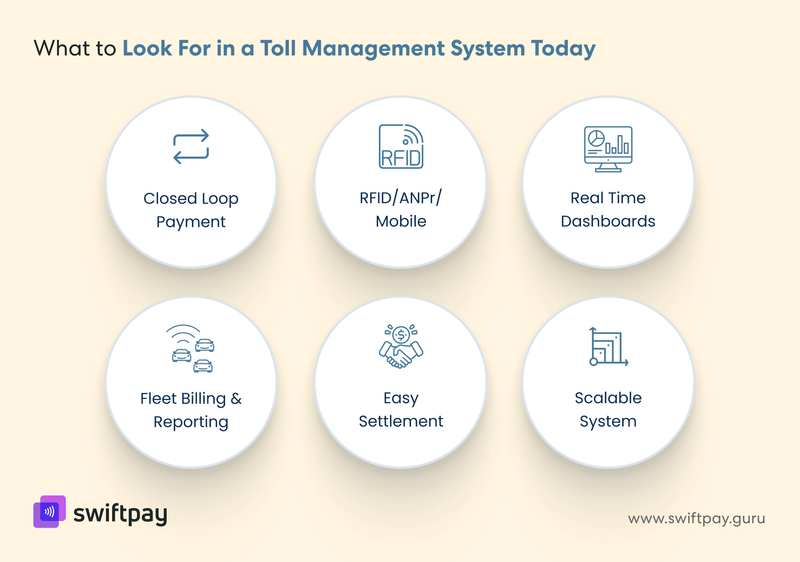
If you’re thinking of updating your tech stack or even just future-proofing what you already have, your next automated toll collection system should do more than track who paid what.
Here’s what actually matters now, and should be considered when you choose a toll management system:
Closed-loop capabilities as standard
With a modern toll management system, closed-loop payment features are included by default. This means you can process payments efficiently without any need to set up additional features.
Compatibility with RFID, ANPR, and mobile payments
You can offer your drivers multiple payment options. Whether they use RFID tags, license plate recognition, or mobile apps, your system can handle all of these without adding complexity.
Read more: Role of RFID and GPS in Automatic Toll Collection Systems
Real-time dashboards and alerts
You get instant visibility into transactions and system activity. Dashboards and alerts show what’s happening as it occurs, which helps you respond quickly to any issues.
Fleet-level billing and reporting
With this feature, your users can manage their accounts, which reduces support requests and makes your fleet operations easier to handle.
Simple settlement and reconciliation tools
Tracking and reporting payments is straightforward. Your finance team can monitor every transaction without relying on spreadsheets or manual calculations.
Built to scale
This payment system can grow with your network. You can expand operations without switching platforms or compromising efficiency. So, it's a smart choice to have on your platform.
At SwiftPay.Guru, this is exactly what we have built our system to do. We work with toll operators and mobility projects that need reliable, easy-to-adopt toll fleet management systems that actually fit their operations.
It is simple, with no extra steps or layers. It’s a system that works for you.
Conclusion
When you’re still operating through traditional toll systems, you end up doing more work than necessary. You carry the burden of transaction fees, wait through delayed settlements, and lose visibility on the very revenue that keeps your network moving. That doesn’t reflect how tolling should work, and it certainly doesn’t reflect how you should be running it.
The problem isn’t tolling. It’s the outdated payment model that puts others in control of your cash flow, your data, and your user experience.
That’s where SwiftPay.Guru helps you move forward.
With a closed-loop toll management system software designed around your operation, you can simplify collections, take back control of revenue, and offer drivers a smoother, faster journey without having to change everything in one go.
The system you need is already set up. Now your toll collection system can run smoothly with your existing system, scale as needed, and let your team focus on priorities that matter.
FAQs
It’s a toll payment solution where the operator manages the entire payment process directly. It allows your drivers to pay through an internal wallet or account, without third-party involvement.
Yes, you can run a closed-loop payment system smoothly with your current toll infrastructure. It integrates easily with your existing gates, RFID systems, and toll management software.
No. It works for all areas, including the city toll zones, private bridges, expressways, and multi-lane highways alike.
Not necessarily, your drivers can use RFID, QR, or mobile applications, all depending on your system.
Since everything runs within your system, reconciliation becomes faster and more accurate, often in real-time.
